Evaluating UK's COVID-19 Vaccine Campaign: Communication Strategies
VerifiedAdded on 2023/06/18
|7
|2052
|241
Report
AI Summary
This report examines the UK government's communication strategies in promoting the COVID-19 vaccine, addressing the barriers that hindered vaccine uptake, and evaluating the success of government initiatives. It delves into communication theories like Attribution Theory to understand public perception of the vaccine. The report identifies physical, emotional, informational, attitudinal, and cultural barriers that prevented people from getting vaccinated. It further analyzes the government's strategies to overcome these barriers, including pharmaceutical interventions, isolating infected individuals, supporting healthcare services, providing public advice, and conducting testing and tracing programs. The success of the vaccination program, with a significant percentage of the population receiving vaccinations, is attributed to these comprehensive strategies. The report concludes by emphasizing the importance of effective communication in addressing public health crises and promoting vaccine awareness.
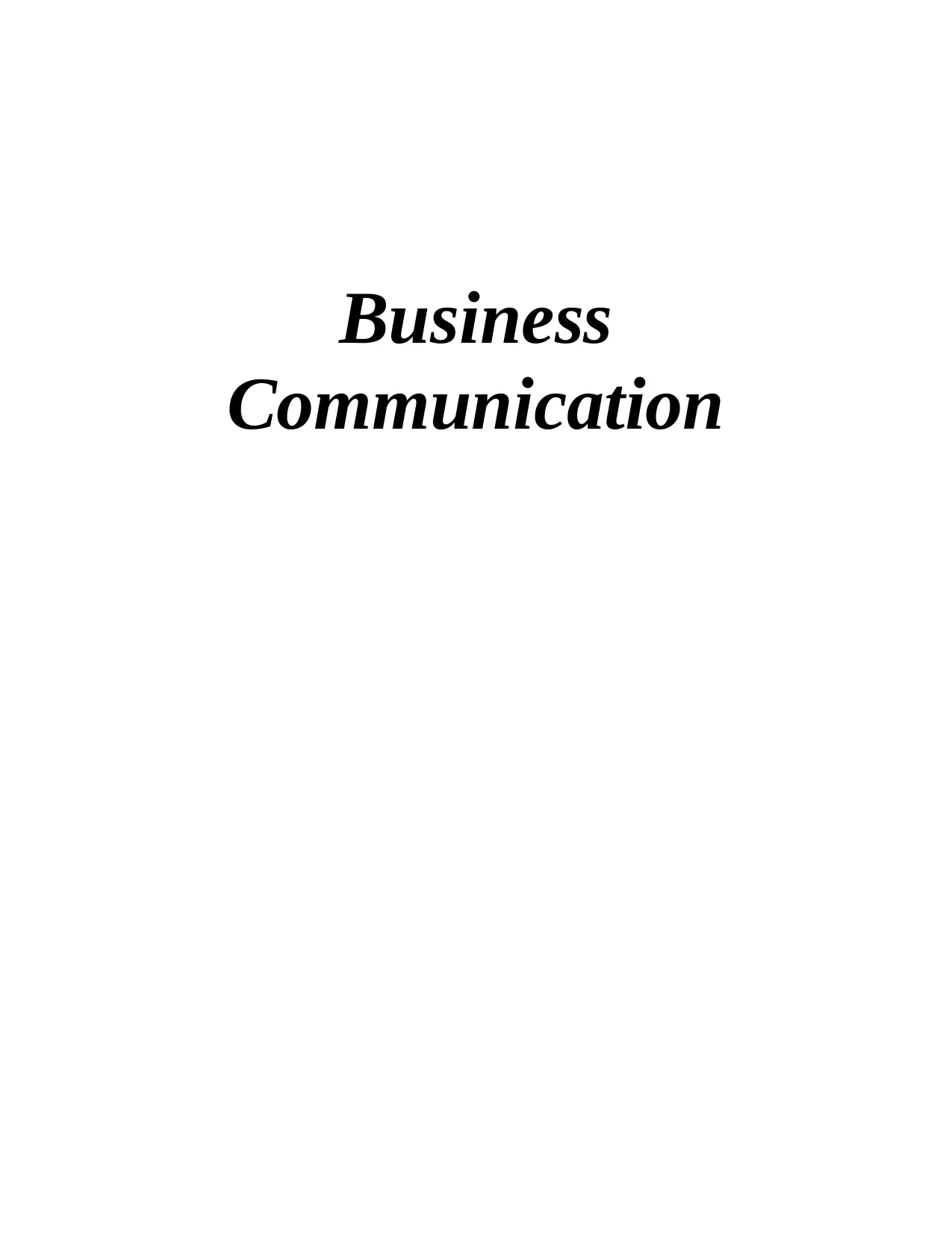
Business
Communication
Communication
Paraphrase This Document
Need a fresh take? Get an instant paraphrase of this document with our AI Paraphraser
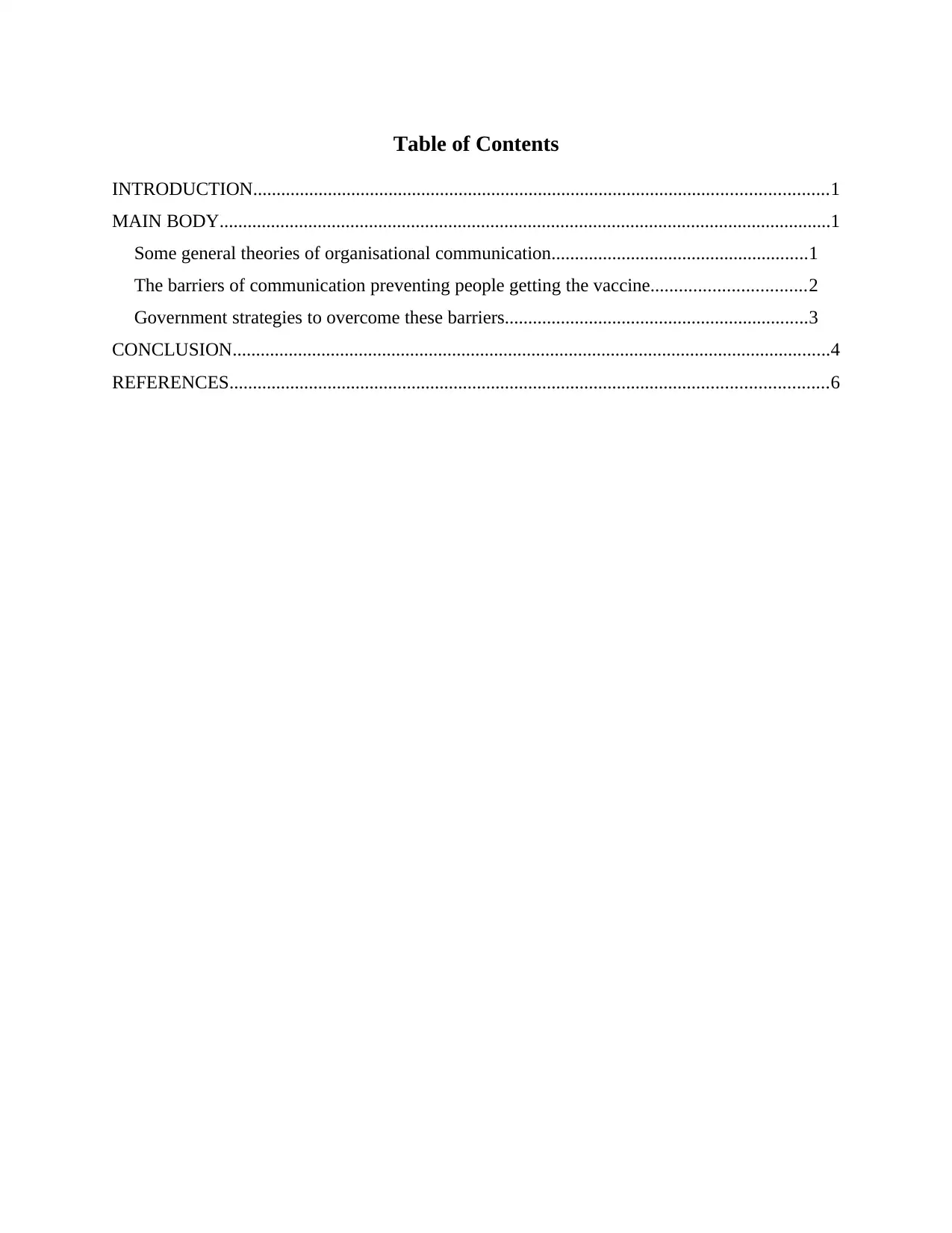
Table of Contents
INTRODUCTION...........................................................................................................................1
MAIN BODY...................................................................................................................................1
Some general theories of organisational communication.......................................................1
The barriers of communication preventing people getting the vaccine.................................2
Government strategies to overcome these barriers.................................................................3
CONCLUSION................................................................................................................................4
REFERENCES................................................................................................................................6
INTRODUCTION...........................................................................................................................1
MAIN BODY...................................................................................................................................1
Some general theories of organisational communication.......................................................1
The barriers of communication preventing people getting the vaccine.................................2
Government strategies to overcome these barriers.................................................................3
CONCLUSION................................................................................................................................4
REFERENCES................................................................................................................................6

INTRODUCTION
COVID-19 also known as novel coronavirus was first discovered in China in 2019, and
worldwide spread during the year 2020. this virus cause severe respiratory disease along with
pneumonia and this became pandemic in the whole world. This pandemic not only developed
health risks among humans but also impacted economies of several countries. Vaccine was
created as a medical solution for this virus by different countries (Patel, 2020). But many people
ignored taking vaccine as they are not aware about the benefits of vaccine or has fear of its side
effects. This report focuses on the theories of communications and challenges faced by
government of UK while making people aware about vaccine. Furthermore, it also explains the
success of initiatives taken by government to get citizens of country vaccinated and it has to
informed to the Primed minister of UK about this campaign.
MAIN BODY
Some general theories of organisational communication
Communication theories explains the importance of an effective communication which is
requires in every organisation in order to pass information to different people efficiently
(Boateng, 2020). One of the communication theory is explained below in detail:
Attribution Theory:
Attribution is a psychological term which explains how an individual understand the
cause of daily experience, as being either exterior or interior. This theory deals with how
common people describe the reasons of behaviour and circumstances. It analyses what
information is being collected and how it is united to make a concluding judgement. This theory
was proposed by Fritz Heider who believed that there is a strong requirement in person to
understand temporary events by assigning them to the disposition of actor or to steady features of
environment (Maikola, 2021). There were two main ideas he introduced that became influential:
Dispositional Attribution (Internal cause):
This allocate the reason of behaviour to some interior characteristics of an individual
rather than to external forces. It has been observed that internal attribution is used to explain
behaviour of others rather than an individual own.
Situational Attribution (External cause):
1
COVID-19 also known as novel coronavirus was first discovered in China in 2019, and
worldwide spread during the year 2020. this virus cause severe respiratory disease along with
pneumonia and this became pandemic in the whole world. This pandemic not only developed
health risks among humans but also impacted economies of several countries. Vaccine was
created as a medical solution for this virus by different countries (Patel, 2020). But many people
ignored taking vaccine as they are not aware about the benefits of vaccine or has fear of its side
effects. This report focuses on the theories of communications and challenges faced by
government of UK while making people aware about vaccine. Furthermore, it also explains the
success of initiatives taken by government to get citizens of country vaccinated and it has to
informed to the Primed minister of UK about this campaign.
MAIN BODY
Some general theories of organisational communication
Communication theories explains the importance of an effective communication which is
requires in every organisation in order to pass information to different people efficiently
(Boateng, 2020). One of the communication theory is explained below in detail:
Attribution Theory:
Attribution is a psychological term which explains how an individual understand the
cause of daily experience, as being either exterior or interior. This theory deals with how
common people describe the reasons of behaviour and circumstances. It analyses what
information is being collected and how it is united to make a concluding judgement. This theory
was proposed by Fritz Heider who believed that there is a strong requirement in person to
understand temporary events by assigning them to the disposition of actor or to steady features of
environment (Maikola, 2021). There were two main ideas he introduced that became influential:
Dispositional Attribution (Internal cause):
This allocate the reason of behaviour to some interior characteristics of an individual
rather than to external forces. It has been observed that internal attribution is used to explain
behaviour of others rather than an individual own.
Situational Attribution (External cause):
1
⊘ This is a preview!⊘
Do you want full access?
Subscribe today to unlock all pages.

Trusted by 1+ million students worldwide
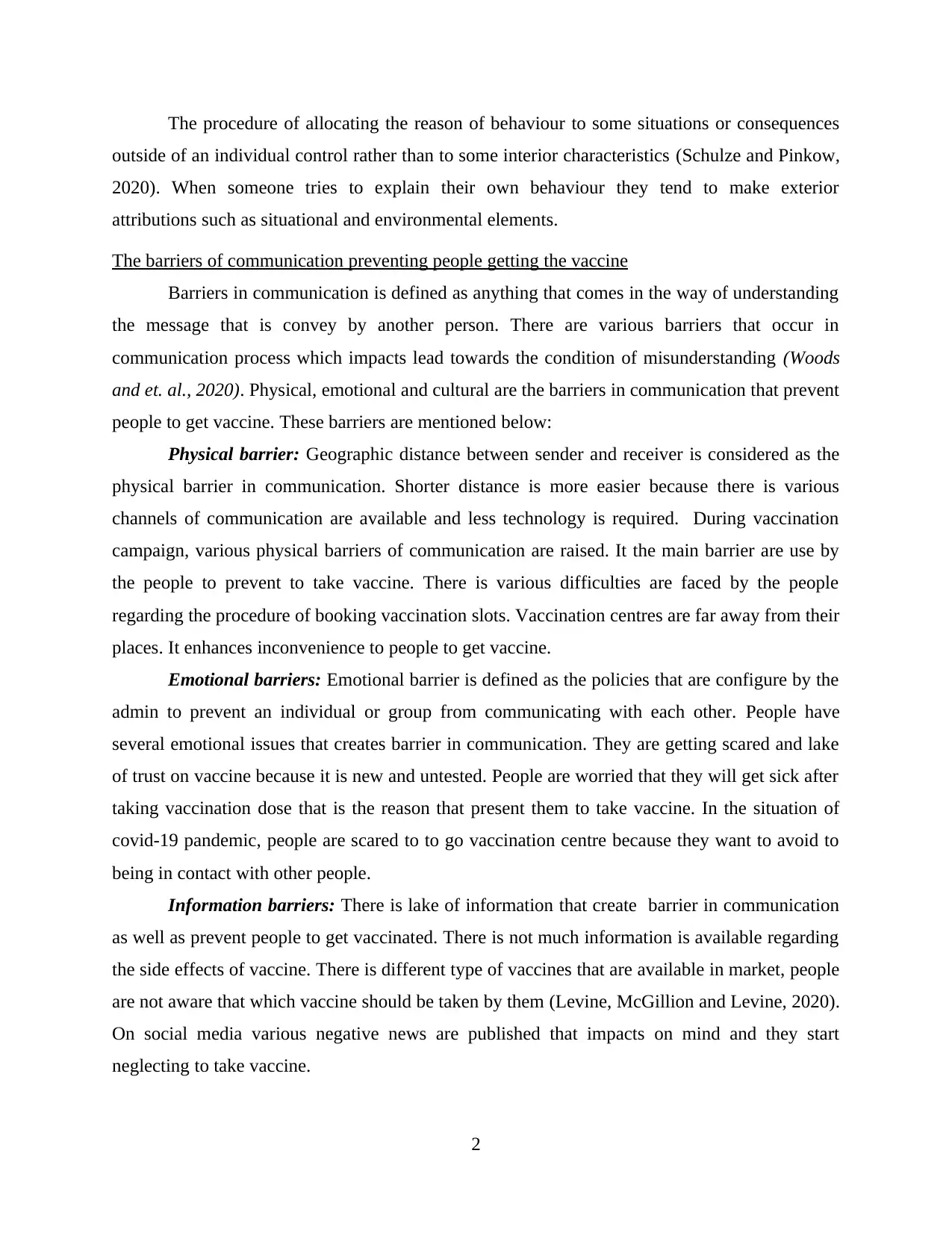
The procedure of allocating the reason of behaviour to some situations or consequences
outside of an individual control rather than to some interior characteristics (Schulze and Pinkow,
2020). When someone tries to explain their own behaviour they tend to make exterior
attributions such as situational and environmental elements.
The barriers of communication preventing people getting the vaccine
Barriers in communication is defined as anything that comes in the way of understanding
the message that is convey by another person. There are various barriers that occur in
communication process which impacts lead towards the condition of misunderstanding (Woods
and et. al., 2020). Physical, emotional and cultural are the barriers in communication that prevent
people to get vaccine. These barriers are mentioned below:
Physical barrier: Geographic distance between sender and receiver is considered as the
physical barrier in communication. Shorter distance is more easier because there is various
channels of communication are available and less technology is required. During vaccination
campaign, various physical barriers of communication are raised. It the main barrier are use by
the people to prevent to take vaccine. There is various difficulties are faced by the people
regarding the procedure of booking vaccination slots. Vaccination centres are far away from their
places. It enhances inconvenience to people to get vaccine.
Emotional barriers: Emotional barrier is defined as the policies that are configure by the
admin to prevent an individual or group from communicating with each other. People have
several emotional issues that creates barrier in communication. They are getting scared and lake
of trust on vaccine because it is new and untested. People are worried that they will get sick after
taking vaccination dose that is the reason that present them to take vaccine. In the situation of
covid-19 pandemic, people are scared to to go vaccination centre because they want to avoid to
being in contact with other people.
Information barriers: There is lake of information that create barrier in communication
as well as prevent people to get vaccinated. There is not much information is available regarding
the side effects of vaccine. There is different type of vaccines that are available in market, people
are not aware that which vaccine should be taken by them (Levine, McGillion and Levine, 2020).
On social media various negative news are published that impacts on mind and they start
neglecting to take vaccine.
2
outside of an individual control rather than to some interior characteristics (Schulze and Pinkow,
2020). When someone tries to explain their own behaviour they tend to make exterior
attributions such as situational and environmental elements.
The barriers of communication preventing people getting the vaccine
Barriers in communication is defined as anything that comes in the way of understanding
the message that is convey by another person. There are various barriers that occur in
communication process which impacts lead towards the condition of misunderstanding (Woods
and et. al., 2020). Physical, emotional and cultural are the barriers in communication that prevent
people to get vaccine. These barriers are mentioned below:
Physical barrier: Geographic distance between sender and receiver is considered as the
physical barrier in communication. Shorter distance is more easier because there is various
channels of communication are available and less technology is required. During vaccination
campaign, various physical barriers of communication are raised. It the main barrier are use by
the people to prevent to take vaccine. There is various difficulties are faced by the people
regarding the procedure of booking vaccination slots. Vaccination centres are far away from their
places. It enhances inconvenience to people to get vaccine.
Emotional barriers: Emotional barrier is defined as the policies that are configure by the
admin to prevent an individual or group from communicating with each other. People have
several emotional issues that creates barrier in communication. They are getting scared and lake
of trust on vaccine because it is new and untested. People are worried that they will get sick after
taking vaccination dose that is the reason that present them to take vaccine. In the situation of
covid-19 pandemic, people are scared to to go vaccination centre because they want to avoid to
being in contact with other people.
Information barriers: There is lake of information that create barrier in communication
as well as prevent people to get vaccinated. There is not much information is available regarding
the side effects of vaccine. There is different type of vaccines that are available in market, people
are not aware that which vaccine should be taken by them (Levine, McGillion and Levine, 2020).
On social media various negative news are published that impacts on mind and they start
neglecting to take vaccine.
2
Paraphrase This Document
Need a fresh take? Get an instant paraphrase of this document with our AI Paraphraser
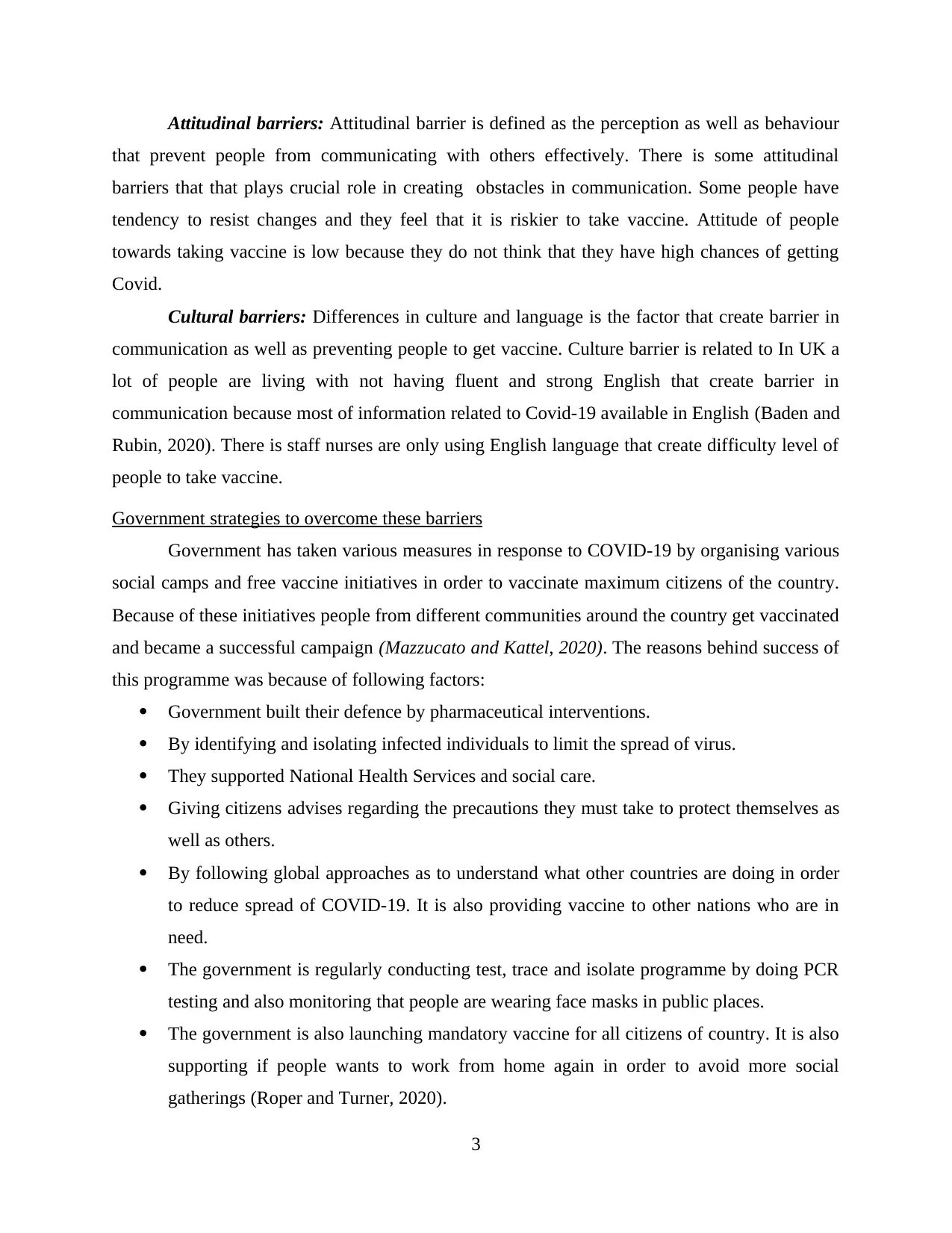
Attitudinal barriers: Attitudinal barrier is defined as the perception as well as behaviour
that prevent people from communicating with others effectively. There is some attitudinal
barriers that that plays crucial role in creating obstacles in communication. Some people have
tendency to resist changes and they feel that it is riskier to take vaccine. Attitude of people
towards taking vaccine is low because they do not think that they have high chances of getting
Covid.
Cultural barriers: Differences in culture and language is the factor that create barrier in
communication as well as preventing people to get vaccine. Culture barrier is related to In UK a
lot of people are living with not having fluent and strong English that create barrier in
communication because most of information related to Covid-19 available in English (Baden and
Rubin, 2020). There is staff nurses are only using English language that create difficulty level of
people to take vaccine.
Government strategies to overcome these barriers
Government has taken various measures in response to COVID-19 by organising various
social camps and free vaccine initiatives in order to vaccinate maximum citizens of the country.
Because of these initiatives people from different communities around the country get vaccinated
and became a successful campaign (Mazzucato and Kattel, 2020). The reasons behind success of
this programme was because of following factors:
Government built their defence by pharmaceutical interventions.
By identifying and isolating infected individuals to limit the spread of virus.
They supported National Health Services and social care.
Giving citizens advises regarding the precautions they must take to protect themselves as
well as others.
By following global approaches as to understand what other countries are doing in order
to reduce spread of COVID-19. It is also providing vaccine to other nations who are in
need.
The government is regularly conducting test, trace and isolate programme by doing PCR
testing and also monitoring that people are wearing face masks in public places.
The government is also launching mandatory vaccine for all citizens of country. It is also
supporting if people wants to work from home again in order to avoid more social
gatherings (Roper and Turner, 2020).
3
that prevent people from communicating with others effectively. There is some attitudinal
barriers that that plays crucial role in creating obstacles in communication. Some people have
tendency to resist changes and they feel that it is riskier to take vaccine. Attitude of people
towards taking vaccine is low because they do not think that they have high chances of getting
Covid.
Cultural barriers: Differences in culture and language is the factor that create barrier in
communication as well as preventing people to get vaccine. Culture barrier is related to In UK a
lot of people are living with not having fluent and strong English that create barrier in
communication because most of information related to Covid-19 available in English (Baden and
Rubin, 2020). There is staff nurses are only using English language that create difficulty level of
people to take vaccine.
Government strategies to overcome these barriers
Government has taken various measures in response to COVID-19 by organising various
social camps and free vaccine initiatives in order to vaccinate maximum citizens of the country.
Because of these initiatives people from different communities around the country get vaccinated
and became a successful campaign (Mazzucato and Kattel, 2020). The reasons behind success of
this programme was because of following factors:
Government built their defence by pharmaceutical interventions.
By identifying and isolating infected individuals to limit the spread of virus.
They supported National Health Services and social care.
Giving citizens advises regarding the precautions they must take to protect themselves as
well as others.
By following global approaches as to understand what other countries are doing in order
to reduce spread of COVID-19. It is also providing vaccine to other nations who are in
need.
The government is regularly conducting test, trace and isolate programme by doing PCR
testing and also monitoring that people are wearing face masks in public places.
The government is also launching mandatory vaccine for all citizens of country. It is also
supporting if people wants to work from home again in order to avoid more social
gatherings (Roper and Turner, 2020).
3

Government also introduced various criteria about who can get vaccine of COVID-19
and what are the eligibility required to get vaccinated which are discussed below:
People who are aged above 18 could get 1st and 2nd dose of vaccine by booking their
appointment at vaccination centres or NHS would call them. Children between the age of 16 and
17 must wait for their turn of vaccination as NHS will contact them. People who are at high risk
of getting sick from COVID-19, they have had an official letter from NHS stating that they are
clinically ill and from this they can book an appointment for their dose (Daumas and et. al.,
2020). Citizens with critical health conditions such as long term lung infection, heart disease,
diabetes and chronic kidney disease than NHS will contact them for their turn of vaccine.
Anyone who is front-line health workers they can contact their nearest vaccination centre.
Because of these steps taken by government more than 48 million citizens of UK get their
first dose of vaccine with around nine in ten of those people were aged between 16 or above and
had their first jab. Out of 48 million people, 89% of them were above 16 and about 44 million
which is almost 81% of population above 16 have had their both dose. The government is giving
approximately 74,000 second doses of vaccine every day. The country is among those countries
which have highest vaccination rates worldwide. Statistics from 'Office for National Statistics'
shows that more than nine in ten adults in country have antibodies for coronavirus. The main
purpose of this vaccination programme is to defend more people as possible from COVID-19 by
developing immunity for population in the country against virus (Covid vaccine: How many
people in the UK have been vaccinated so far?, 2021).
CONCLUSION
From the above discussion it could be evaluated that COVID-19 created physical health
as well as mental health risks among people. As this virus is spreading rapidly across the world,
it is generating fear, worry and confusion in the population which is leading to stress or anxiety
among people. For making people aware about the vaccine it is very important to have an
effective communication between government and citizens. Many people lacks information
regarding the vaccine and how it is beneficial for them which creates miscommunications among
them. It also been observed that by taking various steps and organising camps for people for
vaccine, government has achieved success in getting maximum population vaccinated.
4
and what are the eligibility required to get vaccinated which are discussed below:
People who are aged above 18 could get 1st and 2nd dose of vaccine by booking their
appointment at vaccination centres or NHS would call them. Children between the age of 16 and
17 must wait for their turn of vaccination as NHS will contact them. People who are at high risk
of getting sick from COVID-19, they have had an official letter from NHS stating that they are
clinically ill and from this they can book an appointment for their dose (Daumas and et. al.,
2020). Citizens with critical health conditions such as long term lung infection, heart disease,
diabetes and chronic kidney disease than NHS will contact them for their turn of vaccine.
Anyone who is front-line health workers they can contact their nearest vaccination centre.
Because of these steps taken by government more than 48 million citizens of UK get their
first dose of vaccine with around nine in ten of those people were aged between 16 or above and
had their first jab. Out of 48 million people, 89% of them were above 16 and about 44 million
which is almost 81% of population above 16 have had their both dose. The government is giving
approximately 74,000 second doses of vaccine every day. The country is among those countries
which have highest vaccination rates worldwide. Statistics from 'Office for National Statistics'
shows that more than nine in ten adults in country have antibodies for coronavirus. The main
purpose of this vaccination programme is to defend more people as possible from COVID-19 by
developing immunity for population in the country against virus (Covid vaccine: How many
people in the UK have been vaccinated so far?, 2021).
CONCLUSION
From the above discussion it could be evaluated that COVID-19 created physical health
as well as mental health risks among people. As this virus is spreading rapidly across the world,
it is generating fear, worry and confusion in the population which is leading to stress or anxiety
among people. For making people aware about the vaccine it is very important to have an
effective communication between government and citizens. Many people lacks information
regarding the vaccine and how it is beneficial for them which creates miscommunications among
them. It also been observed that by taking various steps and organising camps for people for
vaccine, government has achieved success in getting maximum population vaccinated.
4
⊘ This is a preview!⊘
Do you want full access?
Subscribe today to unlock all pages.

Trusted by 1+ million students worldwide
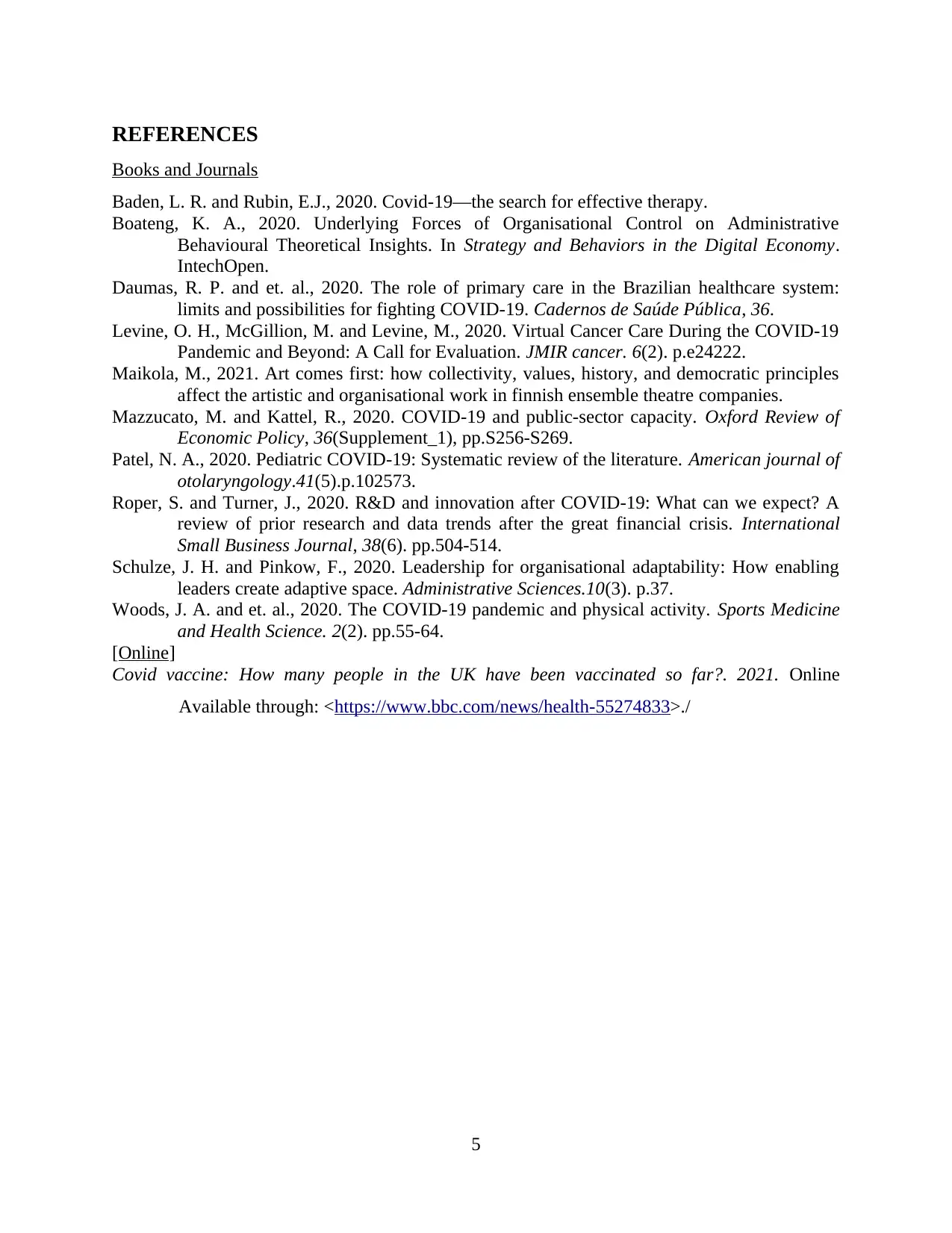
REFERENCES
Books and Journals
Baden, L. R. and Rubin, E.J., 2020. Covid-19—the search for effective therapy.
Boateng, K. A., 2020. Underlying Forces of Organisational Control on Administrative
Behavioural Theoretical Insights. In Strategy and Behaviors in the Digital Economy.
IntechOpen.
Daumas, R. P. and et. al., 2020. The role of primary care in the Brazilian healthcare system:
limits and possibilities for fighting COVID-19. Cadernos de Saúde Pública, 36.
Levine, O. H., McGillion, M. and Levine, M., 2020. Virtual Cancer Care During the COVID-19
Pandemic and Beyond: A Call for Evaluation. JMIR cancer. 6(2). p.e24222.
Maikola, M., 2021. Art comes first: how collectivity, values, history, and democratic principles
affect the artistic and organisational work in finnish ensemble theatre companies.
Mazzucato, M. and Kattel, R., 2020. COVID-19 and public-sector capacity. Oxford Review of
Economic Policy, 36(Supplement_1), pp.S256-S269.
Patel, N. A., 2020. Pediatric COVID-19: Systematic review of the literature. American journal of
otolaryngology.41(5).p.102573.
Roper, S. and Turner, J., 2020. R&D and innovation after COVID-19: What can we expect? A
review of prior research and data trends after the great financial crisis. International
Small Business Journal, 38(6). pp.504-514.
Schulze, J. H. and Pinkow, F., 2020. Leadership for organisational adaptability: How enabling
leaders create adaptive space. Administrative Sciences.10(3). p.37.
Woods, J. A. and et. al., 2020. The COVID-19 pandemic and physical activity. Sports Medicine
and Health Science. 2(2). pp.55-64.
[Online]
Covid vaccine: How many people in the UK have been vaccinated so far?. 2021. Online
Available through: <https://www.bbc.com/news/health-55274833>./
5
Books and Journals
Baden, L. R. and Rubin, E.J., 2020. Covid-19—the search for effective therapy.
Boateng, K. A., 2020. Underlying Forces of Organisational Control on Administrative
Behavioural Theoretical Insights. In Strategy and Behaviors in the Digital Economy.
IntechOpen.
Daumas, R. P. and et. al., 2020. The role of primary care in the Brazilian healthcare system:
limits and possibilities for fighting COVID-19. Cadernos de Saúde Pública, 36.
Levine, O. H., McGillion, M. and Levine, M., 2020. Virtual Cancer Care During the COVID-19
Pandemic and Beyond: A Call for Evaluation. JMIR cancer. 6(2). p.e24222.
Maikola, M., 2021. Art comes first: how collectivity, values, history, and democratic principles
affect the artistic and organisational work in finnish ensemble theatre companies.
Mazzucato, M. and Kattel, R., 2020. COVID-19 and public-sector capacity. Oxford Review of
Economic Policy, 36(Supplement_1), pp.S256-S269.
Patel, N. A., 2020. Pediatric COVID-19: Systematic review of the literature. American journal of
otolaryngology.41(5).p.102573.
Roper, S. and Turner, J., 2020. R&D and innovation after COVID-19: What can we expect? A
review of prior research and data trends after the great financial crisis. International
Small Business Journal, 38(6). pp.504-514.
Schulze, J. H. and Pinkow, F., 2020. Leadership for organisational adaptability: How enabling
leaders create adaptive space. Administrative Sciences.10(3). p.37.
Woods, J. A. and et. al., 2020. The COVID-19 pandemic and physical activity. Sports Medicine
and Health Science. 2(2). pp.55-64.
[Online]
Covid vaccine: How many people in the UK have been vaccinated so far?. 2021. Online
Available through: <https://www.bbc.com/news/health-55274833>./
5
1 out of 7
Related Documents
Your All-in-One AI-Powered Toolkit for Academic Success.
+13062052269
info@desklib.com
Available 24*7 on WhatsApp / Email
![[object Object]](/_next/static/media/star-bottom.7253800d.svg)
Unlock your academic potential
Copyright © 2020–2025 A2Z Services. All Rights Reserved. Developed and managed by ZUCOL.





